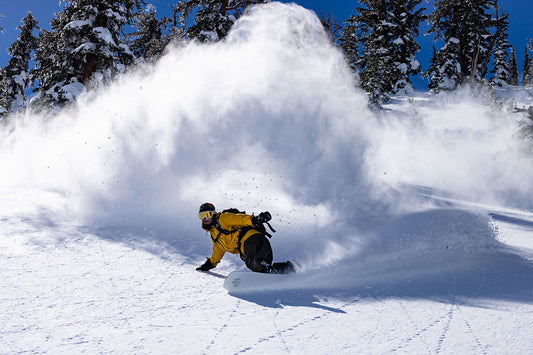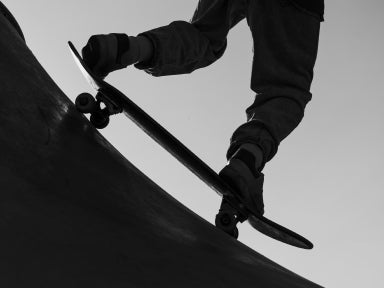Whether you just picked up your first snowboard setup or have been riding for a while, knowing how to dial in your snowboard stance is essential. Your snowboard stance works best for your unique body and enhances your natural ability to snowboard. Finding your stance can take some time to dial in, but understanding the fundamentals will help you adapt your stance to any riding conditions or style.
The First Step
Are you Goofy or Regular? The first step of any snowboard stance is to figure out your dominant foot. Like finding out if you’re Right or Left handed, figuring out if you’re Goofy or Regular will affect everything you do in snowboarding. If you stand with your Right foot out in front facing downhill, you’re what they call Goofy Footed. If your Left foot is your more dominant and leads you downhill, you’re Regular Footed. There are a few ways you can find out which one you are:
- Do you skate? If you skate most likely you already know if you’re goofy or regular. Like snowboarding, when you skate you push goofy or regular depending on your dominant foot.
- The push test. You’ll need a buddy for this one. Stand with your feet parallel and shoulder length apart. Have your buddy give you a surprise light shove from behind. Whichever foot you use to catch yourself is your dominant foot and will be in front when riding downhill.
- Walk up the stairs. When you walk up stairs you’ll instinctually put out your lead foot.
Now that you know which foot is in front we can walk you through ways to set up your bindings to compliment your riding style.
Riding Style
Snowboard setups are designed to fully adjust to the rider’s style and preferred terrain to ride. Every adjustment to your stance is made to make carving down the mountain more intuitive and effective. We’ll take you step by step through the ways to set up your stance and dial it in.
Step By Step
1. Stance Width: You’ll need some measuring tape for this. Your stance width is the distance between your bindings. The best way to figure out your stance width is first, to stand on your snowboard with your feet shoulder width apart at the middle point of your binding inserts. Slowly inch your feet apart to widen your stance. When you feel a slight pressure on your hips, stop and return your feet to a position that is slightly wider than shoulder width but comfortable to stand in. Measure the distance between your feet with some measuring tape.
How to Mount: To begin the mounting process, place your bindings over the inserts the distance you measured apart.

Step 2. Binding Angles: The angles of your front and back binding play a huge role in how your body moves with your snowboard. Your hips and knees align and move in different ways depending on which direction your feet are pointing. Your binding hardware will have a disc that has angle markings that read 0º to -30º degrees in two directions. The front binding should always be angled toward the nose at a +15º to +21º, angling your front foot towards the nose drives your front foot pressure into a turn. If you find it hard to carve, try turning your binding angle out more, if you feel pressure on your knees and the outside of your foot turn your angles in. Some riders change their angles depending on what board, terrain, or style they are riding. Your personal riding style will help you find your front and back binding angle. The three binding angle styles are:
- Neutral: Most snowboarders start with this stance. It is ideal for learning the fundamentals or all mountain riding. If you are riding a directional board or just like cruising the slopes without riding switch very often, this is the angle for you! Angle your front binding toward the nose (typically at +15º) and keep your back binding set perpendicular to your edge at 0º. Setting your back foot at zero is also a great place to start as you experiment with the angle of your front binding.
- Ducked: Terrain park shredders who ride switch and freestyle riders who like a wide stance for balance often prefer a duck stance. Angle your front binding toward the nose and angle your back binding toward the tail, typically only a few degrees of negative angle in the back binding (-3º to -12º degrees). That little bit of negative angle can drastically improve your stability, landing, and riding switch.
- Alpine: Alpine stance is ideal for Alpine or freeride riders. Angle your front and back bindings toward the nose, typically only a few degrees of positive angle in the back binding (+3º to +12º degrees). By slightly turning your back binding toward the nose it aligns both your knees into the same plane and makes it easier for you to dive into turns and more aggressive riding.

How to Mount: Grab your baseplates that come with your binding’s hardware and place them in your bindings. Then insert the hardware into the appropriate inserts and begin to tighten them with a screw driver by hand in a criss cross pattern. Do not tighten the hardware all the way, make sure you can still adjust your bindings. Start at 0º on both baseplates and then set your angle appropriately.

Step 3. Dial It In: Now that you’ve got your stance width and angles figured out and lined up in your snowboard inserts, it’s time to dial in the fine tuned adjustments on your set up.
Center your bindings over your snowboard. Make sure the heel cup of the binding and the toe ramp don’t stick too far off the board. Then finish tightening your hardware all the way until you meet resistance. DO NOT over-tighten your bindings! It will cause the base of your snowboard to warp over your inserts.

Don’t forget to adjust your straps to fit your boots properly. They should be centered over your toe, and the ankle strap centered over the tongue of the boot. Most bindings don’t require tools to adjust your straps.

Adjusting your forward lean helps keep your knees bent and your weight balanced over your snowboard. It also gives you more leverage and power when transitioning from a heelside to a toeside turn. Play around with this and adjust your forward lean to your personal comfort.

Your stance can change depending on your level of riding, the style of riding, the terrain, or the type of snowboard. Understanding the fundamentals of how to adjust your stance to your personal preference will enhance your snowboarding. Now go out and dial in your new whip for the ultimate shred-sperience!
If you still have questions ask one of our experts for help! And sign up to become a team rider at ShredShop.com/enlist and start enjoying all the benefits of riding with us.



